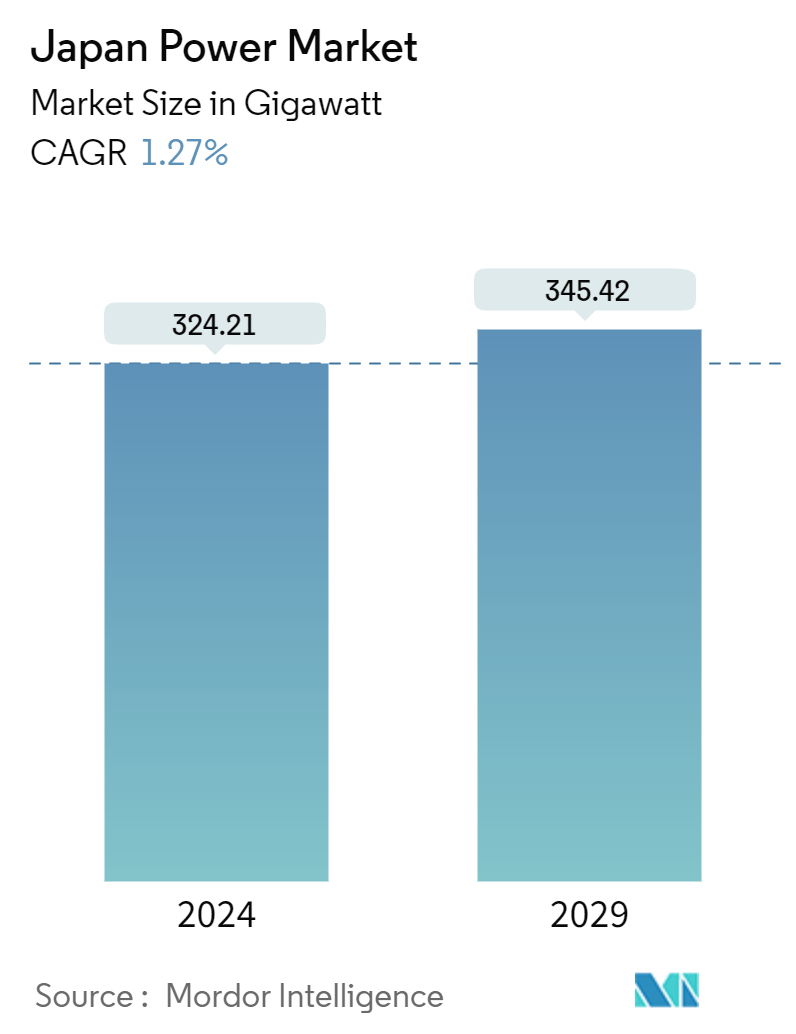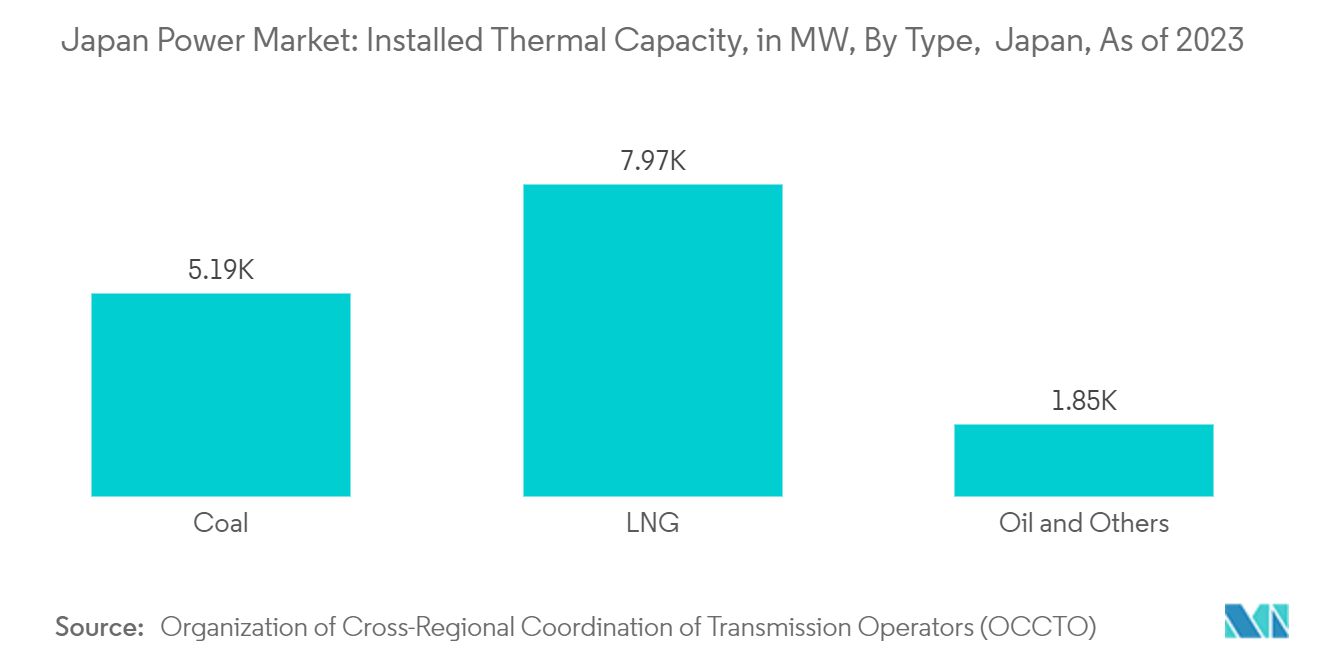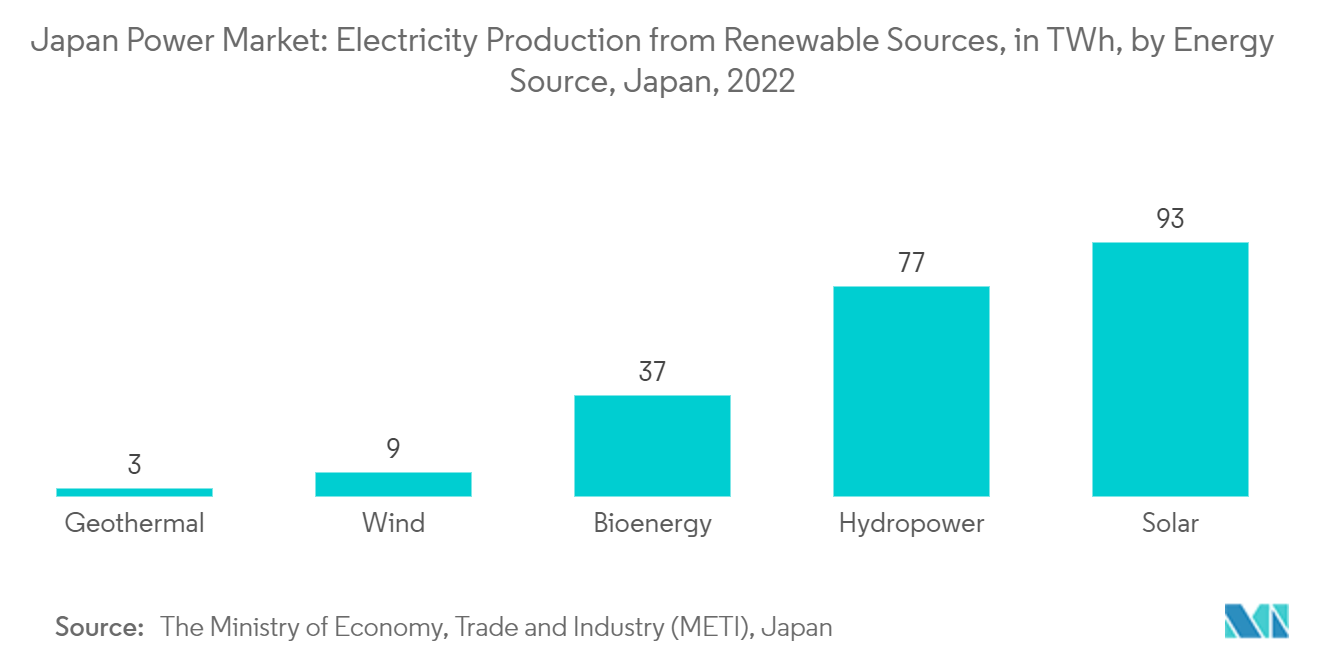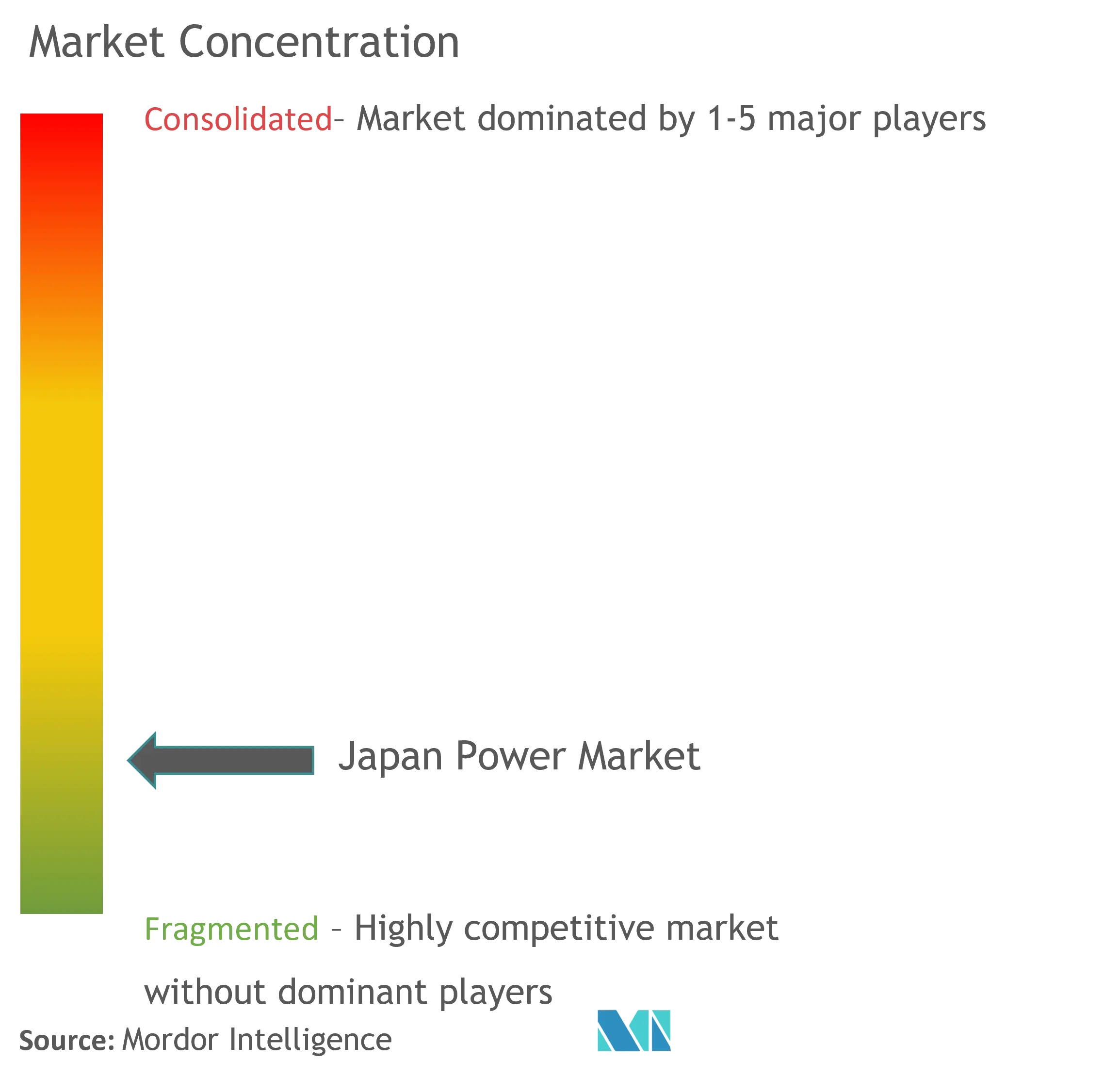Japan Power Market Size

| Study Period | 2019 - 2029 |
| Base Year For Estimation | 2023 |
| Forecast Data Period | 2024 - 2029 |
| Historical Data Period | 2019 - 2022 |
| CAGR (2024 - 2029) | 1.27 % |
| Market Concentration | Medium |
Major Players
*Disclaimer: Major Players sorted in no particular order |
Japan Power Market Analysis
The Japan Power Market size is estimated at 324.21 gigawatt in 2024, and is expected to reach 345.42 gigawatt by 2029, growing at a CAGR of 1.27% during the forecast period (2024-2029).
- Over the medium period, the declining price and installation cost of solar PV systems, advancements in renewable energy technologies, and supportive government initiatives are expected to drive the Japanese power market.
- On the other hand, the rising LNG costs and high reliance on imports impact natural gas power generation and are expected to hinder market growth during the forecast period.
- Nevertheless, the progress in Japan’s offshore wind power sector is likely to create several opportunities for the Japanese power market in the future.
Japan Power Market Trends
Thermal Power Generating Source is Expected to Dominate the Market
- As of 2023, Japan’s thermal power plant sector was the largest contributor to Japan’s power mix, accounting for nearly 46.96% of the country’s total installed capacity. As of 2023, according to the Organization of Cross-Regional Coordination of Transmission Operators (OCCTO), the country had nearly 150.06 GW of installed thermal capacity, coming from more than 481 power plants.
- According to Ministry of Economy, Trade, and Industry (METI) data, Japan has nearly 214 electricity generation companies that own thermal electricity generation assets. However, the Japanese thermal power market is dominated by former general electric utilities, with only ten companies having a total installed thermal capacity exceeding 3 GW, which include major companies such as Hokkaido Electric Power Co., Tohoku Electric Power Co., JERA, Hokuriku Electric Power Co., and Kansai Electric Power Co.
- The Japanese thermal power sector is dominated by LNG-fired plants, which account for nearly 53.1% of the total power capacity. According to METI statistics, Japan has 69 plants, with an average installed capacity of 1.1 GW. This is followed by coal-fired power plants, which account for nearly 95 plants and 32.2% of the total installed capacity.
- However, since the start of the Russia-Ukraine conflict, Japan’s LNG supply situation has become increasingly dire. For instance, in 2023, nearly 6 million tonnes/year (MTPA) of long-term LNG supply contracts expired, which was expected to reduce the country’s contractual LNG supply by nearly 8%.
- To reverse this trend, Japanese companies negotiated new deals with major LNG-supplying nations in 2022. For instance, in December 2022, Japanese companies signed major long-term LNG procurement deals with the United States and Oman to secure fuel supplies and avoid future shortages. In December 2022, Japanese electricity generator JERA and trading houses Mitsui & Co. and Itochu Corp. signed a basic agreement with supplier Oman LNG to import a total of about 2 MTPA of LNG from Oman over ten years, starting from 2025.
- Therefore, owing to the factors mentioned above, the thermal source for power generation is expected to be the largest segment of the power market during the forecast period.

Advancements in Renewable Energy Technologies and Supportive Government Initiatives
- Japan's renewable power sector is poised for significant growth, driven by robust government initiatives to transition toward cleaner energy sources and ongoing advancements in renewable technology. The nation has set ambitious climate targets, aiming for carbon neutrality.
- In October 2021, Japan unveiled its Sixth Strategic Energy Plan, outlining a goal to elevate the share of renewable energy in its energy mix by 36% to 38% by 2030. With a shift away from nuclear power, Japan is increasingly embracing renewables like solar, wind, and tidal power, aiming to reduce reliance on foreign energy and foster domestic energy innovation.
- In October 2020, the Japanese Ministry of Economy, Trade, and Industry (METI) unveiled the Japanese Green Growth Strategy, aiming for carbon neutrality by 2050. The strategy outlined an ambitious push for renewables, a revival of nuclear power, and the adoption of cutting-edge technologies like low-carbon hydrogen, advanced nuclear reactors, and carbon recycling. In 2021, the strategy underwent revisions, emphasizing significant investments in energy and other sectors' research and innovation, potentially influencing corporate R&D policies. These developments are poised to drive advancements in renewable technologies.
- In April 2021, Fujitsu Limited and AutoGrid Systems Inc. announced Fujitsu's plans to introduce AutoGrid's Virtual Power Plant (VPP) solution to the Japanese market. This move aims to optimize the utilization of distributed energy resources, bolster renewable energy adoption, and accelerate decarbonization efforts.
- In 2022, the electricity produced from solar power in Japan stood at about 93 TWh, and hydropower accounted for over 77 TWh. To reduce greenhouse gas emissions and be less dependent on fossil fuel imports, the Japanese government is currently working on expanding electricity production from renewable energy sources in the forthcoming years.
- As part of the agreement, Fujitsu is set to market AutoGrid's flagship VPP solution, the AutoGrid FlexTM, in Japan. These systems offer enhanced monitoring and control capabilities, optimizing power generation operations. Japan is actively seeking cost-effective, low-carbon electricity production technologies, making advancements in renewables pivotal for the country's energy landscape in the coming years.
- Given this strong government backing, including policies, schemes, and ambitious renewable targets, the renewable energy market in Japan is poised for growth in the coming years.

Japan Power Industry Overview
The Japanese power market is semi-fragmented. Some of the key players in the market (not in a particular order) include Tokyo Electric Power Company, Tohoku Electric Power Company, Hokkaido Electric Power Company, Chubu Electric Power Company, and Hokuriku Electric Power Company.
Japan Power Market Leaders
-
Hokkaido Electric Power Company
-
Tohoku Electric Power Company
-
Tokyo Electric Power Company
-
Chubu Electric Power Company
-
Hokuriku Electric Power Company
*Disclaimer: Major Players sorted in no particular order

Japan Power Market News
- October 2023: J-Power, a major player in the Japanese power sector, unveiled its strategy to shutter two coal-fired power plants at its Matsushima facility in southern Japan. Each of these plants has a capacity of 500 MW. This move aligns with J-Power's goal of curbing carbon dioxide (CO2) emissions by 2025. As the second-largest coal-fired power producer in Japan, trailing only JERA, J-Power is set to permanently close its No.1 plant and temporarily halt operations at the No.2 plant by March 2025. In a bid to enhance efficiency and reduce emissions, J-Power is considering constructing a gasification facility at the No.2 plant, with plans to recommence operations in 2028.
- October 2022: Wartsila's technology group supplied gas-fuelled engines for the new 100 MW Japanese power plant. The new plant is going to operate with 10 Wartsila 34SG gas engines, replacing a 100 MW combined cycle gas turbine previously located on the site.
Japan Power Market Report - Table of Contents
1. INTRODUCTION
- 1.1 Scope of the Study
- 1.2 Market Definition
- 1.3 Study Assumptions
2. EXECUTIVE SUMMARY
3. RESEARCH METHODOLOGY
4. MARKET OVERVIEW
- 4.1 Introduction
- 4.2 Installed Power Generation Capacity and Forecast , till 2029
- 4.3 Electricity Generation and Forecast , Japan, till 2029
- 4.4 Renewable Energy Mix, Japan, 2022
- 4.5 Recent Trends and Developments
- 4.6 Government Policies and Regulations
-
4.7 Market Dynamics
- 4.7.1 Drivers
- 4.7.1.1 Declining Price and Installation Cost of Solar PV Systems
- 4.7.1.2 Advancements in Renewable Energy Technologies and Supportive Government Initiatives
- 4.7.2 Restraints
- 4.7.2.1 Rising LNG Costs and High Reliance on Imports Impact Natural Gas Power Generation
- 4.8 Supply Chain Analysis
- 4.9 PESTLE Analysis
5. MARKET SEGMENTATION
-
5.1 Power Generation Source
- 5.1.1 Thermal
- 5.1.2 Hydroelectric
- 5.1.3 Nuclear
- 5.1.4 Renewable
- 5.2 Power Transmission and Distribution (T&D)
6. COMPETITIVE LANDSCAPE
- 6.1 Mergers and Acquisitions, Joint Ventures, Collaborations, and Agreements
- 6.2 Strategies Adopted by Leading Players
-
6.3 Company Profiles
- 6.3.1 Hokkaido Electric Power Company
- 6.3.2 Tohoku Electric Power Company
- 6.3.3 Tokyo Electric Power Company
- 6.3.4 Chubu Electric Power Company
- 6.3.5 Hokuriku Electric Power Company
- 6.3.6 Kansai Electric Power Company
- 6.3.7 Chugoku Electric Power Company
- 6.3.8 Shikoku Electric Power Company
- 6.3.9 Kyushu Electric Power Company
- 6.3.10 Okinawa Electric Power Company
- *List Not Exhaustive
- 6.4 Market Ranking/Share (%) Analysis
7. MARKET OPPORTUNITIES AND FUTURE TRENDS
- 7.1 Progress in Japan’s Offshore Wind Power Sector
Japan Power Industry Segmentaion
The generation of electricity through various sources like fossil fuels, renewable energies, and nuclear energy, as well as the transmission and distribution of electricity to the end user, constitute the power market.
The Japan power market is segmented by power generation source and power transmission and distribution. By power generation source, the market is segmented into thermal, hydroelectric, nuclear, and renewable. Market sizing and forecasts were made based on electricity generation capacity and installed power generation capacity.
| Power Generation Source | Thermal |
| Hydroelectric | |
| Nuclear | |
| Renewable |
Japan Power Market Research FAQs
How big is the Japan Power Market?
The Japan Power Market size is expected to reach 324.21 gigawatt in 2024 and grow at a CAGR of 1.27% to reach 345.42 gigawatt by 2029.
What is the current Japan Power Market size?
In 2024, the Japan Power Market size is expected to reach 324.21 gigawatt.
Who are the key players in Japan Power Market?
Hokkaido Electric Power Company, Tohoku Electric Power Company, Tokyo Electric Power Company, Chubu Electric Power Company and Hokuriku Electric Power Company are the major companies operating in the Japan Power Market.
What years does this Japan Power Market cover, and what was the market size in 2023?
In 2023, the Japan Power Market size was estimated at 320.09 gigawatt. The report covers the Japan Power Market historical market size for years: 2019, 2020, 2021, 2022 and 2023. The report also forecasts the Japan Power Market size for years: 2024, 2025, 2026, 2027, 2028 and 2029.
Japan Power Industry Report
Statistics for the 2024 Japan Power market share, size and revenue growth rate, created by Mordor Intelligence™ Industry Reports. Japan Power analysis includes a market forecast outlook to 2029 and historical overview. Get a sample of this industry analysis as a free report PDF download.



